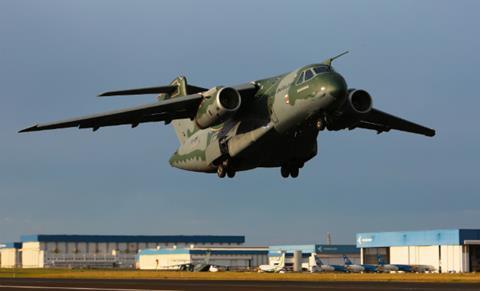Collapse of a joint venture agreement between Boeing and Embraer to promote the Embraer C-390 Millennium will likely make it more difficult to sell the medium-lift transport outside of Brazil, seriously hurting the overall sales of the aircraft programme.
The deal, in which Embraer would have owned a 51% stake and Boeing a 49% stake, was terminated after the two sides could not get past some final sticking points, said Boeing on 25 April.

The joint venture was awaiting approval from the European Commission and was operating under a “master transaction agreement”, a preliminary arrangement ahead of the formation of a new company.
However, the deadline to meeting certain conditions under that master transaction agreement was 24 April. Certain conditions were not met and the two parties could not agree to an extension of the preliminary agreement, says Boeing.
Boeing did not disclose what the unmet “certain conditions” were and declines to comment on the specifics. The also company declines to comment on how much cash will be freed by cancelling the defence joint venture, while Embraer did not immediately respond to a request for comment.
The C-390 is a twin-turbine powered military transport designed by Embraer for the Brazilian air force. The aircraft was originally dubbed KC-390, with the “K” to emphasize the aircraft’s in-flight refuelling capabilities and the “C” representing cargo.
In a sign that they were deepening their relationship ahead of final regulatory approval, at the Dubai air show in November Boeing and Embraer rebranded the KC-390 airlifter as the C-390 Millennium to emphasise the transport’s cargo mission. The joint venture’s name, Boeing Embraer – Defense, was also announced.
The branding KC-390 is retained for certain military customers.
Although the C-390 has been praised, it faced an uphill battle gaining sales outside of Brazil because many militaries around the world are already dedicated to certain aircraft types. The tactical transport market is also relatively small.
Moreover, the market is facing pressure in the coming years. Teal Group projected, last year, that the market will reduce by some 42% to $3.62 billion by 2027. Total units produced across the market are projected to fall about 24% to 56 annually.
Some 20% of the current worldwide transport fleet, 869 aircraft, is made up of the Lockheed Martin C-130 or L-100, according to FlightGlobal’s 2020 World Air Forces Directory. The lion’s share of those C-130s are operated by the US Air Force – the largest buyer of military transports worldwide.
Establishing a joint venture with Boeing opened up the possibility that Embraer could establish a production line in the USA and sell the C-390 to Washington. A production line in the USA, via Boeing, could allow the joint venture to leverage the US government’s Foreign Military Sales security assistance programme which would make it easier to sell the C-390 to international customers.
Now, both options are gone.
Boeing says it plans to retain a master teaming agreement with Embraer, signed in 2012, to jointly market and support the C-390 aircraft. The company declines to comment on the differences between the marketing agreement and the joint venture.
Since September 2019, Embraer has delivered two KC-390s to the Brazilian air force and owes the government a further 25. It has a firm contract to sell five additional units to Portugal. The company has letters of intent for 27 more aircraft for Argentina, Chile, Colombia and the Czech Republic, according to Cirium fleets data.


























